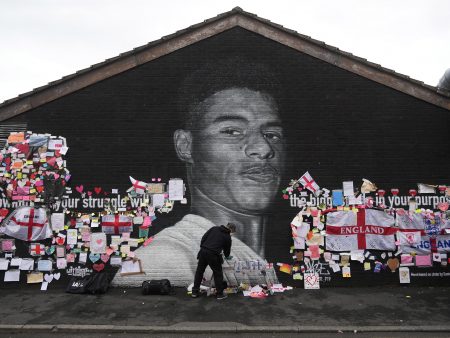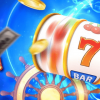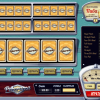В мае 1992 голый европеец Финал Кубка на «Уэмбли» был последним в дополнительное время, когда заменяющий «Сампдории» Джованни Инверницци был — возможно, немного жестко — наказан за фол против игрока «Барселоны» Эусебио Сакристана. Разъяренный рефери, Самп отказался , встал рядом, отбросил мяч и жестикулировал, но штрафной остался. Христо Стоичков перекатил его на Хосе Мари Бакеро,…
В мае 1992 голый европеец Финал Кубка на «Уэмбли» был последним в дополнительное время, когда заменяющий «Сампдории» Джованни Инверницци был — возможно, немного жестко — наказан за фол против игрока «Барселоны» Эусебио Сакристана. Разъяренный рефери, Самп отказался , встал рядом, отбросил мяч и жестикулировал, но штрафной остался.
Христо Стоичков перекатил его на Хосе Мари Бакеро, он остановил мяч и Рональд Куман ударил его в нижний угол сетки.
Барселона выиграла свой первый Кубок европейских чемпионов, Сампдория проиграла.
Их нет 14, капитан команды, который В противном случае он сам поднял трофей, если бы удача повернулась на его сторону, был Роберто Манчини.
За то, что осталось от его карьеры, он все еще наслаждался дальнейшими триумфами, и как менеджер он сделал то же самое, с лигой титулы и второстепенные кубки в его резюме. Но есть что-то экстраординарное и несравненное в том, чтобы выиграть самые большие кубки в день самых ожидаемых финалов. Что-то лишнее . Для всех, кто пытается возродить старый дух прошлых лет, победа в финале Кубка Англии — или Кубка Италии, или Кубка Турции — не совсем так привлекательна, как крупнейшие европейские финалы.
И, несмотря на все его другие успехи, только второй Кубок обладателей кубков за год , достигнутый на «Вилла Парк» с «Лацио», был близок к тому, чтобы заполнить пробел, который упускал из виду ‘ Финал Уэмбли, должно быть, остался за Манчини. Даже это, конечно же, было второстепенным соревнованием УЕФА.
Бросьте на простое 29 лет, и Манчини прошел полный круг, чтобы возглавить команду в прямом смысле слова, к крупной победе в европейском финале … . на Уэмбли. Более того, его доверенное лицо в системе Италии, часть штата в качестве руководителя делегации, не кто иной, как Джанлука Виалли — напарник Манчини после того поражения от «Барселоны». Аттилио Ломбардо тоже был в этой команде «Сампдория» и входит в штат Манчини.
Италия была в смятении, когда Манчини вступил во владение 2018. Широко сообщалось и комментировалось, как они только что не прошли квалификацию на чемпионат мира, проиграв плей-офф Швеции, но это было больше, чем просто не выйти в финал. С ноября 2017 по ноябрь 2018, они выиграли всего два матча из 12 во всех соревнованиях. Состав был меньше, чем сумма его частей, идентичность и стиль команды далеко не ясны. С тех пор путь Манчини через Лигу Наций, квалификационную кампанию и теперь успех на Евро 2021 был одним из исключительных. тимбилдинг, планирование и прогресс.
Футбол любит истории полного цикла, верно? Итак, вот еще один: последний матч, который Италия сыграла до того, как Манчини взял верх, был ничьей 1: 1 против Англии на «Уэмбли».
Последний матч, который Италия провела с Манчини у руля, был … ну, может быть, еще слишком рано возвращаться ко всему этому, но многие компоненты кажутся одинаковыми — за исключением самого важного.
Из итальянских стартовавших в марте ничья, пятеро составили состав на Евро 2020 финал. Если это звучит как капитальный ремонт, стоит отметить, что это был а) товарищеский матч и б) только четыре сборных Англии начали обе игры. Джек Батланд, Джеймс Тарковски и Алекс Окслейд-Чемберлен тогда были среди XI.
«data-gallery-length =» 3 «height =» 725 «i-amphtml-layout =» responsive «layout =» responsive «on =» tap : inline-image-gallery, inline-image-carousel.goToSlide (index = 1) «role =» button «src =» https://static.independent.co.uk/2021 / 07 / 12 / 16 / GettyImages — 1280243708. Jpg? Width = 982 & height = 726 & auto = webp & quality = 75 «tabindex =» 0 «width =» 1024 «> Манчини восстановил сборную Италии после унижения фа готовится к квалификации на 2018 Чемпионат мира (Getty Images)
Тем не менее, нет никаких сомнений в том, что изменения приходили быстро и производились часто. Манчини испытал таких бывших игроков сборной, как Марио Балотелли, открыл возможности для новых лиц и потенциальных столпов, таких как Алессио Романьоли, поработал с системами и, прежде всего, изменил свою полузащиту, чтобы найти идеальное сочетание качества и доверия в центре парка. Защитники приходили и уходили.
Несколько крупных, тяжелых побед над мелкими рыбками в квалификации, Италия играла с Нидерландами в перезапуске после Covid
Джанлуиджи Доннарумма в воротах, четверка защитников Данило Д’Амброзио, Леонардо Бонуччи, Джорджио Кьеллини и Леонардо Спинаццола. В полузащите Жоржиньо в основе рядом с Мануэлем Локателли и Николо Барелла. В атаке Чиро Иммобиле окружал Лоренцо Инсинье и Николо Дзаниоло. Последний нападающий, звезда с «Ромой», способный изменить игру, наверняка был бы в составе — возможно, XI — если бы не травмы крестообразных связок колена, расположенные спина к спине. Единственное другое изменение между этим XI и тем, которое так захватило континент в ночь открытия турнира быстрым взлетом Турции, произошло на правом фланге защитника.
Другие внесли огромный вклад, из Конечно, Марко Верратти не подлежит обсуждению, когда он в хорошей форме, но Манчини пробовал, а иногда и ошибался, и удалял все бесполезные элементы: эгоизм, непоследовательность, неспособность играть в команде.
Результатом является 75 — совпадение беспроигрышная серия и трофей Анри Делоне.
«data-gallery-length =» 3 «height = «725» i-amphtml-layout = «отзывчивый» макет = «responseive» on = «tap: inline-image-gallery, inline-image-carousel.goToSlide (index = 2)» role = «button» src = «https://static.independent.co.uk/2021 / 10 / 14 / 26 / GettyImages — 1328201424. jpg? width = 982 & height = 982 & auto = webp & quality = 92 «tabindex =» 0 «width =» 1024 «> Манчини прошел полный круг, чтобы привести команду к крупной победе в финал на Уэмбли, где он проиграл 1992 финал Кубка европейских чемпионов (Getty Images)
Некоторые считают, что готовность Манчини включать игроков из менее модных клубов является важным фактором их успеха. Если предположить, что большая пятерка — «Юве», «Интер», «Милан», «Рома» и «Наполи» — очевидные клубы, куда можно пойти, принадлежащий 26 пришел извне. Если принять во внимание большие неитальянские команды, то это группа из .
Само по себе это неубедительно: те же критерии показывают восемь в евро отряд и шесть на Евро 2012 ; в то время как в группе успешных чемпионатов мира было девять 2010, но 10 в 2010, когда они не вышли из группового этапа. В конечном счете, для Манчини и Адзурри отличает сочетание характеров и качества, а не цифры каждого клуба. Знакомство помогает, но также помогает соревнование за места и группа, движущаяся в одном направлении, что является самым большим достижением, на которое может надеяться международный главный тренер.
Это больше всего на свете. то, что Манчини установил вокруг команды: клубный уровень бай-ина, клубный уровень тактической осведомленности, организация и даже иерархия игроков, к которым можно было бы обратиться.
Это потребовало почти три десятилетия, но шедевр работы в землянке помог Манчини успокоить призраков не только худшего часа Италии в современной истории футбола, но и его собственного момента душевной боли Уэмбли.

















